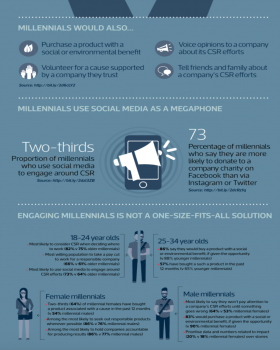Despite only recently becoming a key term in business, Corporate Social Responsibility (CSR) has been practiced and promoted for decades. Elihu Spencer notes that in recent years, the term “business ethics” has become “linked to the concept of ‘corporate social responsibility,’ an umbrella term calling on businesses to act as responsible citizens of their communities, even at the cost of profits.” CSR encourages employees to see themselves as “citizens,” not only members of a corporation but also members and participants within the local and global community. The concept of CSR bases itself on the notion that businesses succeed and operate due to the public’s “consent” and this “license to operate” comes with corporate obligation to give back to the public and the community.
The values of CSR also require leaders to think about the impact of their work not only on the organization and its members, but also the larger society and environment. CSR is particularly important to the Millennial generation, who expect and desire CSR programs to be included in the companies they work for. Based on extensive research case studies, surveys, and interviews, Lancaster and Stillman identify that Millennials want and expect philanthropic/civic engagement structured into their company’s organizational culture and mission. Today more and more companies are emphasizing CSR to accommodate and appeal to the Millennial generation’s expectation and desire for their job to have a meaningful, positive impact on the community, on social and environmental causes, and on their country.” Millennials have indicated that employee-volunteer opportunities are major factor in their commitment to a job, with “77% of millennials prefer[ing]to donate their skills instead of their money.”

Ways Businesses Can Leverage Millennial Talents, Tastes, and Trends for CSR-Many corporations recognize that CSR leads to increased employee productivity, self-integrity, engagement, participation, job satisfaction, professional development and organizational commitment. CSR also leads to more socially responsible investments, improvements to work culture, and Sustainable Business Practices (SBPs) that “do less harm” to people and the planet.
Adopt a Triple Bottom Line Approach to Business- Within companies there is a greater emphasis on CSR to address corruption, labor, and environmental issues (e.g. the creation of a new executive position to ensure that all Walmart employees are complying with the U.S. Foreign Corrupt Practices Act after corruption and bribery scandals involving Walmart employees in Mexico, India, and Russia; creation of “energy-saving strategies” such as the first sustainable refrigeration distribution center in Canada, where environmental issues are a big concern; establishment of measures to ensure worker safety after deadly factory accidents in India).
One theory for why these issues occur is that a traditional model of western capitalism values profit over people and the planet, putting the ROI of the company’s shareholders above that of its stakeholders. According to Chouinard & Stanley, the notion of a responsible company is different today than it was in both the 1860s and 1960s. Traditionally, in the 1800s, a responsible company would be one that made a return on its shareholders’ investment; however, today a responsible company is one whose business practices and business model considers all the stakeholders, not just shareholders. The age of mechanized labor and machines led to companies in the 1960s being legally obligated to be responsible to its workers, its consumers, and its community. The authors point out the responsible company in the 1960s had an organizational structure that was hierarchical and patriarchal.
Today a responsible company also has a responsibility to nature, to preserve and conserve natural resources. This concept is of critical importance to understanding sustainable business practices (SBPs) because companies can no longer just consider the bottom line, not only provide a return to the stockholders or shareholders, but also a return to nature.
It is imperative that any business consider ways to operate sustainably and ethically, utilizing a CSR approach that emphasizes the “triple bottom line,” which involves companies paying “equal attention to profits, people, and the planet.”
Adopt Sustainable Business Practices (SBPs)-It is important to adopt and understand sustainable business practices (SBPs) because companies can no longer just consider the bottom line, not only provide a return to the stockholders or shareholders, but also a return to the stakeholders, one of which is nature. In terms of the issue of sustainability, the “200 year old industrial model” of business has wrecked the environment and contributed to overconsumption — the western production of “crap,” — “the design, production, and consumption of things we don’t need and aren’t good for us. A responsible company today is one that prepares itself for the transition to a post-consumerist society through the adoption of SBPs. According to Chouinard & Stanley, CSR requires companies to assume five core responsibilities:
- Responsibility to the health of the business
- Responsibility to the workers
- Responsibility to the customers/clients
- Responsibility to the community
- Responsibility to nature
Ethics and equity are the two words that shape the meaning of justice. Ethical and sustainable business practices must always have equity as an underlying framework. Equity means fairness in the way of treating people and the planet, in terms of access to opportunity, resources, support, and networks. An equity-based meaning of justice also involves businesses adopting ethical and sustainable practices that help to mitigate social, systemic, environmental and economic disparities.
Foster a Sense of Corporate Citizenship-There are a wide variety of stakeholders on the local, national, and international level affected by a CSR approach to business. As within nations, within corporations, citizens have certain rights and responsibilities. According to the Boston College Center for Corporate Citizenship, “Corporate citizenship is how a company exercises its rights, obligations, privileges, and overall corporate responsibility within our local and global environments. The measurement and return on investment (ROI) of corporate responsibility and corporate citizenship is defined by how well companies responsibly manage not only their financial performance but also their environmental and social impact.” Fostering a sense of corporate citizenship and CSR also involves companies encouraging and allowing workers to contribute a percentage of their work time to volunteer and community activities in which they “make a difference.” Employee activities and activism that are globally-minded and culturally/socially resonant make people feel good about the work they do and the company they work.

Ways Millennials Can Promote and Practice CSR-Many people think of activism as an action that takes place apart from, or even against, the corporation. However, the Millennial generation has shown how activism and volunteerism can exist with(in) the world of business. Businesses and their employees can become “agents of change” through increased community engagement and involvement in solving issues/problems in their industry, field, or locality. Millennials can take the lead in devising strategies for businesses to incorporate more CSR into their mission, values, organizational culture, and human resources/relations.
“Culture Thinking”: Making a Meaningful Life, Work, and Contributions-Millennials can be “agents of change” inside and outside the workplace by changing the whole way of thinking about the relationship between life, work, and activism. One important way is through a mindfulness technique called “culture thinking.” As those of us already working in the corporate world know, the products we create can shape the ways of life and behaviors of the people who use them. According to Damian Madray “Culture in its broadest sense is cultivated behavior; that is the totality of a person’s learned, accumulated experience which is socially transmitted, or more briefly, behavior through social learning.” Madray argues that businesses today must engage in culture thinking because it is the socially responsible thing to do (we must consider the cultural and environmental impact of what we produce) and also the practical and successful thing to do (a product that fails to consider how its design fits into the culture will not be successful— he uses the example of Google Glass). This notion of “culture thinking” once again brings us back to CSR and thinking more deeply about the designing and producing products and services that are socially and environmentally responsible.
Use “Applied Intelligence” to Assist the Company in Building CSR-A really powerful idea from Chouinard & Stanley is the notion of “applied intelligence,” which means that “The company will get smarter, and more people will start to care deeply about creating a better-quality business through improving its social and environmental performance.” The authors offer two steps toward building a company’s applied intelligence about social and environmental issues. The first step is for employees to identify what they already know, what they think are the company’s strengths and what the company is good at getting done. The second step is to then get input from all the employees to decide what causes the company should devote itself to.

Photo by Shridhar Gupta on Unsplash
For Millennials, think about how those causes that you are passionate about and how they align with the company’s values, mission statement, and traits. Related to this notion of “applied intelligence” is the notion of building the company’s shared knowledge about a social and environmental initiative and putting them into practice, SBPs. The authors link corporate social responsibility to sharing knowledge: “As you learn, share what you learn with as many people as possible in your organization…. Then share what you learn with stakeholders: suppliers, your trade association, key customers, even key competitors.”
Featured Image Photo by Sean Pollock on Unsplash




